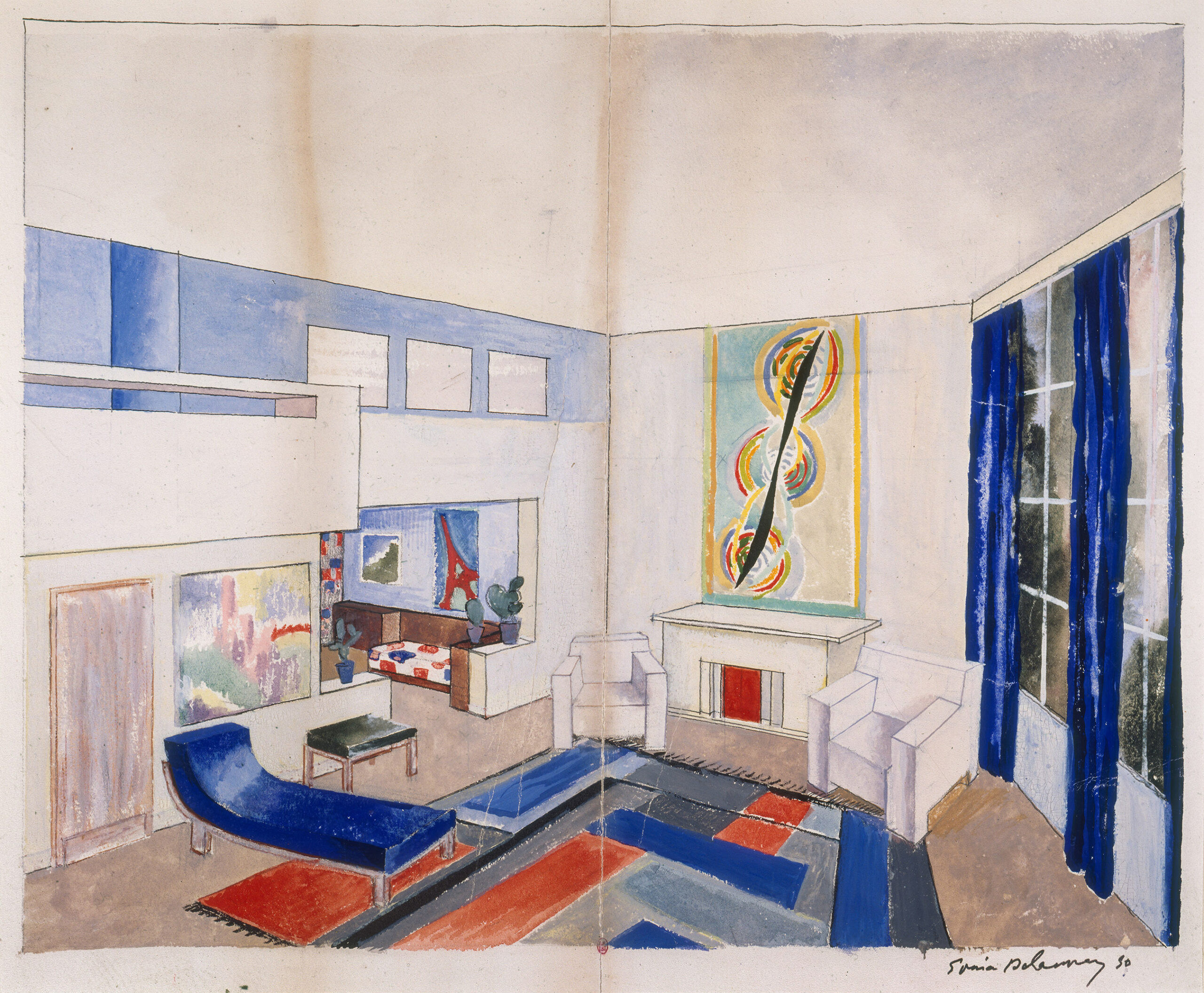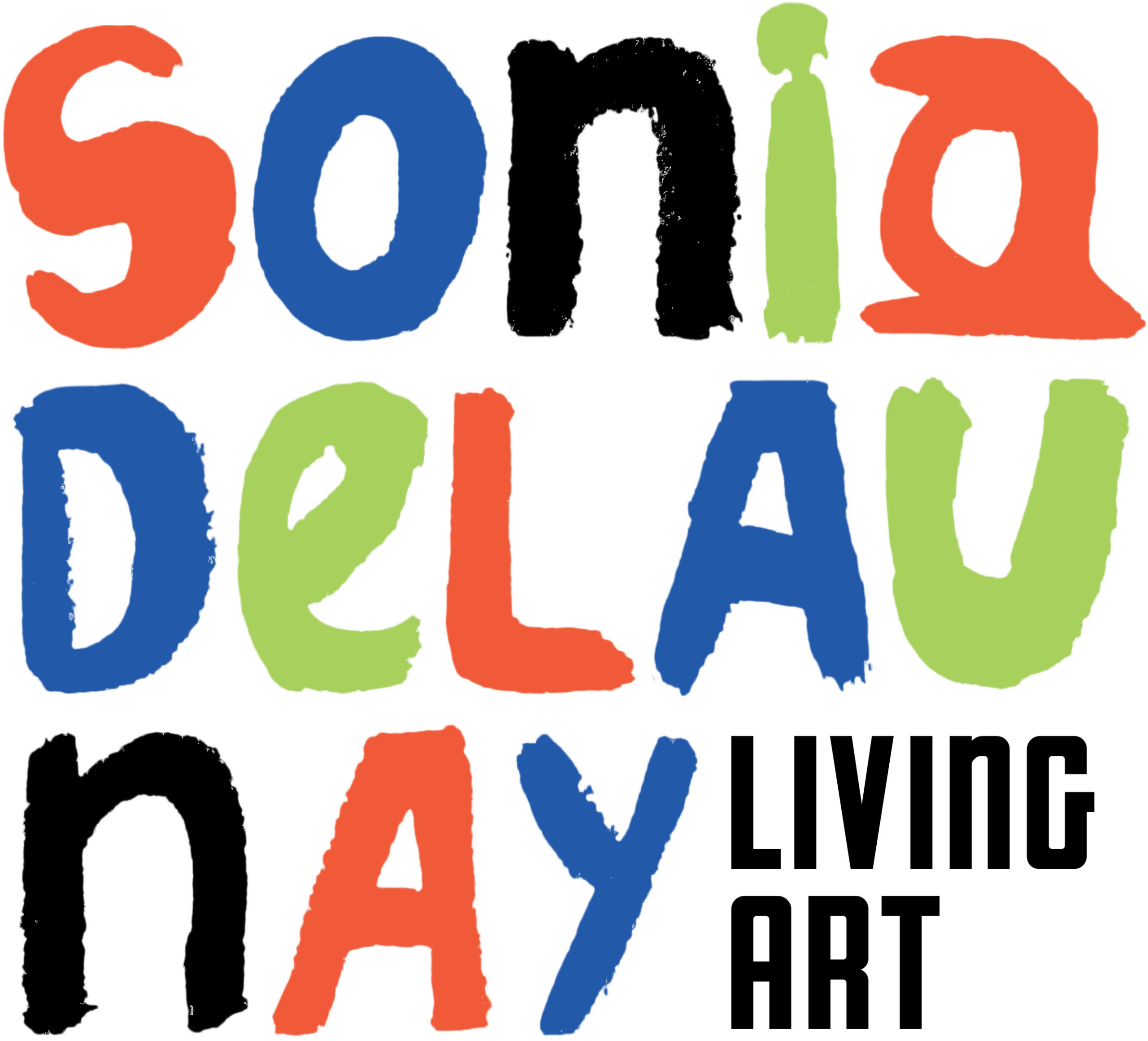INTERIORS: THE ART AND DESIGN OF SPACE
The design of furniture, decorative textiles, and objects became central to Sonia Delaunay’s commercial pursuits in the mid-1920s. She began work in this realm by transforming her own domestic spaces, which she decorated to reflect her singular artistic vision. From rugs and curtains to the custom-made sycamore furniture with hand-embroidered upholstery, the Delaunay home on boulevard Malesherbes in Paris was entirely conceived by her. As such, it served as an immersive environment in which to showcase her art and fashion. Beyond her own residences, she decorated the homes of many of her Parisian friends, supplying textiles and furniture and collaborating with other designers and architects to create beautiful, functional rooms enlivened by saturated color. By 1930 Delaunay was a respected authority in the field. She was invited to conceive a model interior for the first exhibition organized by the Union des artistes modernes (UAM) and to give a lecture on domestic design by the League for Household Efficiency. Espousing rationalist principles, Delaunay proposed practical yet stylish dwellings suited to modern life. In her own words, the “poetry of a room” is achieved by its “spiritual or visual aspect,” which, for Delaunay, was best enhanced through the application of color.
INTERIORS: THE ART AND DESIGN OF SPACE
The design of furniture, decorative textiles, and objects became central to Sonia Delaunay’s commercial pursuits in the mid-1920s. She began work in this realm by transforming her own domestic spaces, which she decorated to reflect her singular artistic vision. From rugs and curtains to the custom-made sycamore furniture with hand-embroidered upholstery, the Delaunay home on boulevard Malesherbes in Paris was entirely conceived by her. As such, it served as an immersive environment in which to showcase her art and fashion. Beyond her own residences, she decorated the homes of many of her Parisian friends, supplying textiles and furniture and collaborating with other designers and architects to create beautiful, functional rooms enlivened by saturated color. By 1930 Delaunay was a respected authority in the field. She was invited to conceive a model interior for the first exhibition organized by the Union des artistes modernes (UAM) and to give a lecture on domestic design by the League for Household Efficiency. Espousing rationalist principles, Delaunay proposed practical yet stylish dwellings suited to modern life. In her own words, the “poetry of a room” is achieved by its “spiritual or visual aspect,” which, for Delaunay, was best enhanced through the application of color.
The design of furniture, decorative textiles, and objects became central to Sonia Delaunay’s commercial pursuits in the mid-1920s. She began work in this realm by transforming her own domestic spaces, which she decorated to reflect her singular artistic vision. From rugs and curtains to the custom-made sycamore furniture with hand-embroidered upholstery, the Delaunay home on boulevard Malesherbes in Paris was entirely conceived by her. As such, it served as an immersive environment in which to showcase her art and fashion. Beyond her own residences, she decorated the homes of many of her Parisian friends, supplying textiles and furniture and collaborating with other designers and architects to create beautiful, functional rooms enlivened by saturated color. By 1930 Delaunay was a respected authority in the field. She was invited to conceive a model interior for the first exhibition organized by the Union des artistes modernes (UAM) and to give a lecture on domestic design by the League for Household Efficiency. Espousing rationalist principles, Delaunay proposed practical yet stylish dwellings suited to modern life. In her own words, the “poetry of a room” is achieved by its “spiritual or visual aspect,” which, for Delaunay, was best enhanced through the application of color.
In 1934, Sonia Delaunay embarked on the large-scale renovation of an apartment for engineer Georges Guerchenovich (1902–1978) in the elegant Parisian district of Passy. Delaunay not only was the designer, but also oversaw the budget, commissioned craftsmen, and coordinated technical details on-site. The result was a space characterized by artistic merit and practicality. This aligned with Delaunay’s conviction that an interior should be adapted to suit modern life, merging the functional and the beautiful.
In 1934, Sonia Delaunay embarked on the large-scale renovation of an apartment for engineer Georges Guerchenovich (1902–1978) in the elegant Parisian district of Passy. Delaunay not only was the designer, but also oversaw the budget, commissioned craftsmen, and coordinated technical details on-site. The result was a space characterized by artistic merit and practicality. This aligned with Delaunay’s conviction that an interior should be adapted to suit modern life, merging the functional and the beautiful.
Tap on the image highlights to explore Delaunay’s interior design project for 32, quai d’Auteuil in Paris.
32, QUAI D’AUTEUIL – Mobile

Tap on the image highlights to explore Delaunay’s interior design project for 32, quai d’Auteuil in Paris.
1934
Watercolor and gouache on paper
Bibliothèque nationale de France, Paris, gift of Sonia Delaunay, 1977
1934
Watercolor and gouache on paper
Bibliothèque nationale de France, Paris, gift of Sonia Delaunay, 1977

Tap on the image highlights to explore Delaunay’s interior design project for 32, quai d’Auteuil in Paris.
1934
Watercolor and gouache on paper
Bibliothèque nationale de France, Paris, gift of Sonia Delaunay, 1977
While renovating their apartment on rue Norvins, textile manufacturer Robert Perrier (1898–1987) and his wife, Madeleine (1904–1983), commissioned Sonia Delaunay to decorate the bedroom of their six-year-old daughter, Marie-Jacques “Jacotte” Perrier (1924–2012). Using one of her popular textile designs from 1926, Delaunay created curtains and upholstery, and she painted a wooden table as part of a bright white furniture ensemble. The playful pattern echoed the room’s archway and porthole windows, which evoked windows in a luxury ocean liner.
While renovating their apartment on rue Norvins, textile manufacturer Robert Perrier (1898–1987) and his wife, Madeleine (1904–1983), commissioned Sonia Delaunay to decorate the bedroom of their six-year-old daughter, Marie-Jacques “Jacotte” Perrier (1924–2012). Using one of her popular textile designs from 1926, Delaunay created curtains and upholstery, and she painted a wooden table as part of a bright white furniture ensemble. The playful pattern echoed the room’s archway and porthole windows, which evoked windows in a luxury ocean liner.
This armchair is one of a surviving set of four with two matching poufs designed by Sonia Delaunay for the family’s living room. The chair’s embroidery coordinated with the room’s wallpaper, which was printed after a textile design by Sonia, and its color palette complemented the rug—also created by her. Like the apartment itself, these chairs served multiple functions: seating for guests and customers, set pieces for photo shoots, and examples of Delaunay’s craftsmanship and skill as an interior decorator.
This armchair is one of a surviving set of four with two matching poufs designed by Sonia Delaunay for the family’s living room. The chair’s embroidery coordinated with the room’s wallpaper, which was printed after a textile design by Sonia, and its color palette complemented the rug—also created by her. Like the apartment itself, these chairs served multiple functions: seating for guests and customers, set pieces for photo shoots, and examples of Delaunay’s craftsmanship and skill as an interior decorator.
ca. 1923
Wood, canvas embroidered with wool, and velour
Musée des Arts décoratifs, Paris, gift of Sonia Delaunay, 1979, 46053
ca. 1923
Wood, canvas embroidered with wool, and velour
Musée des Arts décoratifs, Paris, gift of Sonia Delaunay, 1979, 46053
ca. 1925
Photograph
Bibliothèque nationale de France, Paris, gift of Sonia Delaunay, 1977
ca. 1925
Photograph
Bibliothèque nationale de France, Paris, gift of Sonia Delaunay, 1977
In 1929 a group of artists led by architect Robert Mallet-Stevens (1886–1945) formed the Union des artistes modernes (UAM), which emphasized form over decoration and advocated use of new, cost-effective materials. For the group’s first exhibition, Delaunay designed an office with three chairs, a bookcase, and a multipurpose desk. The blue-and-red color scheme of her sketches, a common thread in Delaunay’s interior design projects, suggests that the ensemble was quite vibrant. The display also featured a rug, a folding screen, and curtains, as well as Robert Delaunay’s 1914 painting Hommage à Blériot.
In 1929 a group of artists led by architect Robert Mallet-Stevens (1886–1945) formed the Union des artistes modernes (UAM), which emphasized form over decoration and advocated use of new, cost-effective materials. For the group’s first exhibition, Delaunay designed an office with three chairs, a bookcase, and a multipurpose desk. The blue-and-red color scheme of her sketches, a common thread in Delaunay’s interior design projects, suggests that the ensemble was quite vibrant. The display also featured a rug, a folding screen, and curtains, as well as Robert Delaunay’s 1914 painting Hommage à Blériot.
1930
Pencil and colored pencil on paper
Centre Pompidou, Musée national d’art moderne, Bibliothèque Kandinsky, Paris, Fonds Delaunay, gift of Charles Delaunay, 1985
Sonia Delaunay conceived Simultanism as not just an aesthetic practice, but also a way of life. To visually demonstrate this, she created both small- and large-scale paintings of abstracted figures wearing her designs and situated in colorful spaces often modeled after her own apartment and boutique space on boulevard Malesherbes. These bold compositions, which were also reproduced as pochoir prints, show how Delaunay’s painting, fashion, and decorations were meant to exist in lively conversation with one another.
Sonia Delaunay conceived Simultanism as not just an aesthetic practice, but also a way of life. To visually demonstrate this, she created both small- and large-scale paintings of abstracted figures wearing her designs and situated in colorful spaces often modeled after her own apartment and boutique space on boulevard Malesherbes. These bold compositions, which were also reproduced as pochoir prints, show how Delaunay’s painting, fashion, and decorations were meant to exist in lively conversation with one another.
1925
Gouache and watercolor on paper
Galerie Zlotowski, Paris







